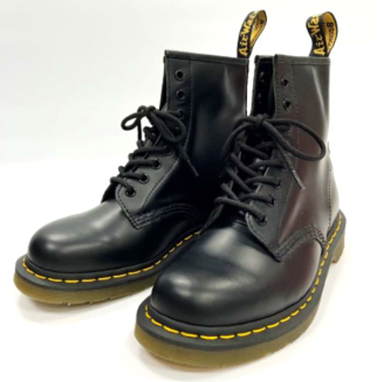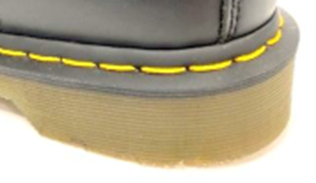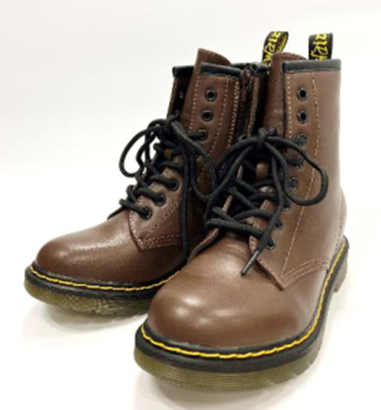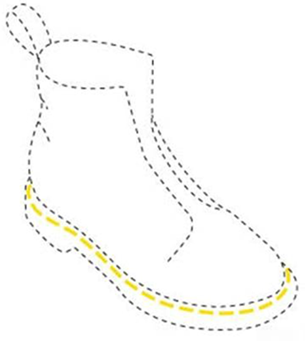May 7, 2024
Trademark News
The IP High Court Grants Protection to Dr. Martens' Shoes Shape Under Unfair Competition Law But Denies Trademark Registration on Position Mark
In 2023, the Intellectual Property High Court of Japan (the "IP High Court") issued two judgments regarding the shape of Dr. Martens' shoes, which is known for the "yellow stitching". In an unfair competition action, the IP High Court found that the overall shape of Dr. Martens' shoes, including the "yellow stitching", was protectable as an indication of source (IP High Court judgment, November 9, 2023 (Case number: 2023(Ne)10048)). However, in another judgment, the IP High Court refused to grant trademark registration to a position mark solely covering the "yellow stitching" (IP High Court judgment, August 10, 2023 (Case number: 2023(Gyo-Ke)10003)).
Dr. Martens' Shoes
"Dr. Martens" is a footwear and clothing brand owned by Air Wear International Limited ("Air Wear"), which is a UK company. Dr. Martens' shoes have many characteristics, but one of the most well-known characteristics is the "yellow stitching" around the welt.
 |
| Dr. Martens' shoes |
 |
| "Yellow stitching" |
Unfair Competition Action
The first case is an unfair competition action brought by Air Wear against a counterfeit seller. In the action, Air Wear asserted that the shape of Dr. Martens' shoes was protected as an "indication of goods or business" under Article 2(1)(i) of the Unfair Competition Prevention Act of Japan (the "UCPA"), and thus that the defendant's act of selling almost identical shoes constituted unfair competition.
Article 2(1)(i) of the UCPA defines as "unfair competition", an act of causing confusion by using an "indication of goods or business" that is identical or similar to another person's well-known "indication of goods or business". An "indication of goods or business" refers to "a name, trade name, trademark, marks, containers or packaging for goods belonging to a person's business, or any other indication of a person's goods or business".
This provision of the UCPA essentially protects well-known unregistered marks against acts that cause consumer confusion.
Under Japanese case law, in order to argue that a three-dimensional shape of a product (without any marks or logos attached) is an "indication of goods or business", the plaintiff must establish the following two points: (A) that the shape has a remarkable characteristic that is different from other products; and (B) that the shape has become well-known among consumers as an indication of a single source of a product, either through an exclusive long-time use by a specific business, or through a strong advertisement or an explosive sales.
In the current case, Air Wear argued that the "yellow stitching", as well as other characteristics of the shape of Dr. Martens' shoes (such as the sole pattern, heel loop and number of holes), satisfied the above two points and thus fell under "indication of goods or services".
In the first instance, the Tokyo District Court held that the "yellow stitching" shown on a black welt is an "indication of goods or services". The court found that such a characteristic of shoes was not found in shoes sold by other manufacturers and thus is remarkable. The court also found that Air Wear started selling Dr. Martens' shoes with the "yellow stitching" in Japan in 1985 and exclusively sold the shoes for nearly 35 years, and that the "yellow stitching" was repeatedly introduced in fashion magazines, Internet articles and social media. Accordingly, the court found that the "yellow stitching" became well-known among consumers as an indication of a single source, and thus constituted "indication of goods or business".
On the other hand, the court did not find other characteristics as "indication of goods or business", because they were either not remarkable or not well-known.
Since the shoes sold by the defendant also used the "yellow stitching", the court found that the defendant's act is unfair competition, and issued an injunction.
 |
| Defendant's Shoes |
On appeal, the IP High Court (the 4th Division) affirmed the district court judgment, but based on a slightly different reasoning.
The IP High Court held that the "yellow stitching", combined with other characteristics asserted by Air Wear (such as the sole pattern, heel loop and number of holes), constituted an "indication of goods or business". The court said that it would be too broad a protection if the "yellow stitching" alone sufficed as an "indication of goods or business".
Another point to note is that the IP High Court relied on a result of a consumer survey conducted by Air Wear, in finding that the shape of Dr. Martens' shoes were well-known among consumers. In the survey, the participants were shown a photograph of Dr. Martens' shoes and were asked to answer the name or manufacturer of the product. In a free answer question, 30.7% of the participants gave a correct answer. In a multiple-choice question, 37.6% of the participants gave a correct answer. The IP High Court referred to this survey result as one of evidence showing that Dr. Martens' shoes were well-known among consumers.
Trademark Application for a Position Mark
Separately from the above unfair competition action, Air Wear filed a trademark application for a position mark that represents the "yellow stitching" in 2018.
In the drawing shown below, the yellow broken lines represent the position mark. On the other hand, the black broken lines do not constitute part of the position mark.
 |
| Position Mark |
The Examiner of the Japan Patent Office (the "JPO") refused to grant trademark registration, pointing out that the position mark lacked inherent distinctiveness.
On an appeal before the JPO Trial Board, Air Wear argued that the position mark acquired secondary meaning through use and thus was registrable under Article 3(2) of the Trademark Act of Japan.
The JPO Trial Board denied the appeal, holding that evidence presented by Air Wear was not sufficient to establish secondary meaning. Air Wear filed a revocation action with the IP High Court, seeking to revoke the JPO Trial Board decision.
The IP High Court (the 2nd Division) affirmed the JPO Trial Board decision.
The IP High Court found that the "yellow stitching", as used on black shoes or boots, was well recognized by Japanese consumers as an indication used by Air Wear. (The court referred to the survey result mentioned above in support of this finding.)
However, the court also found that the "yellow stitching" that is not used in combination with a black or dark background was not well recognized by consumers. Since the background color in the trademark application was not limited to black or dark color, the court held that it cannot be said that the position mark acquired secondary meaning.
Air Wear argued that even if a trademark registration is granted to this position mark, the trademark right would not extend to use of the "yellow stitching" in a manner that is not clearly visible. However, the IP High Court rejected this argument, holding that such manner of use is not excluded from the scope of trademark right, and that Air Wear's argument does not justify granting of registration to a mark that lacks distinctiveness.
Comments
As explained above, a division of the IP High Court in an unfair competition action granted protection to the shape of Dr. Martens' shoes, while a different division of the IP High Court refused to grant trademark registration to a position mark that represents the "yellow stitching".
While the latter judgment seems stricter on Air Wear at first glance, the latter judgment seems to indicate that if the background color were limited to black or dark color, the position mark would be registrable. In the meantime, the former judgment held that the "yellow stitching" alone was not protectable as an "indication of goods or business" and that it was protectable only when combined with other characteristics. Thus, the former judgment is actually stricter to Air Wear than the latter judgment.
Another point to note is that both IP High Court judgments referred to the survey result, which showed that 30.7% of the participants gave a correct answer in a free answer question and 37.6% gave a correct answer in multiple choice question.
This recognition rate (between 30-40%) shown in the above survey result seems relatively low, from our experience. When we Japanese trademark attorneys try to obtain a trademark registration on a three-dimensional shape of a product by showing secondary meaning, we usually aim to show in a survey result a recognition rate of, ideally no less than 70%, or at least 60%.
While the JPO and the court consider survey results as only one of evidence and not necessarily as a decisive factor in finding of secondary meaning, it is quite surprising that the IP High Court referred to the above survey result in favor of finding well recognition by consumers. In future cases, these IP High Court judgments might become helpful to us when trying to show secondary meaning by survey results.
Written by: Mr. Yusuke Inui (Attorney at Law, Patent Attorney)